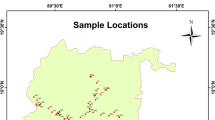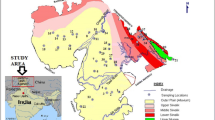Abstract
The article provides the first ever Statewise information on uranium and other toxic elements (Pb, As, Cd, Al, Hg, Se, and Ni) present in excess quantity in groundwater in Punjab State of India. It undertakes detailed analysis of 252 ground water samples, out of total 1,686 samples, which were found exceeding guideline value for uranium in drinking water as specified by different regulating agencies like Atomic Energy Regulatory Board (AERB) India, United States Environmental Protection Agency (USEPA), and World Health Organization (WHO). The groundwater samples were collected from 14 districts for analysis of uranium following suspected high level of uranium in groundwater and possible co-relationship of uranium in drinking water with high incidences of cancer, kidney problem, birth defects, and other abnormalities in some areas in Punjab State of India. Basic information on cancer-related incidences is also given. Keeping in view that there could be multiple reasons of cancer-related incidences and other health hazards, data on pesticide consumption in the State were also collected, and test results of other toxic elements (Pb, As, Cd, Al, Hg, Se, and Ni) in 7,176 groundwater-based drinking water sources are also presented.The analysis reveals that groundwater at many villages, which is used for drinking purpose, is contaminated with uranium and other toxic metals, and consumption of drinking water contaminated with many toxic elements may be one of the reason of high incidences of cancer, kidney problem, birth defects, and other abnormalities in some areas in Punjab State of India.




Similar content being viewed by others
Notes
The criteria for stage of Groundwater Development are computed using following formula—Groundwater Development \(=\) (Existing Gross Draft For All Uses/Net Annual Availability) \(\times \) 100.
References
Alrakabi M, Singh G, Bhalla A, Kumar S, Rai B, Singh N, Sahi GS, Mehta DS, Srivastava A (2012) Study of uranium contamination in groundwater in Punjab State in India using X-ray fluorescence technique. J Radioanal Nucl Chem 291:221–227
Atomic Energy Regulatory Board (2004) Atomic Energy Regulatory Board directive for uranium limit in drinking water
Auvinen A (2002) Uranium and other natural radionuclides in drinking water and risk of leukemia: a case-cohort study in Finland. Cancer Causes Control 13:825–829
Dhillon GS (2009) Uranium concentration in Bhatinda’s groundwater. http://www.tribuneindia.com/2009/20090619/science.htm
Kochhar N, Gill GS, Tuli N, Veena D, Balaram V (2006) Chemical quality of ground water in relation to incidence of cancer in parts of SW Punjab, India. Asian J Water Environ Pollut 4(2):107–112
Kurttio P, Auvinen A, Salonen L, Saha H, Pekkanen J, Mäkeläinen I, Väisänen SB, Penttilä IM, Komulainen H (2002) Renal effects of uranium in drinking water. Environ Health Perspect Apr 110(4):337–342
Kurttio Päivi, Komulainen Hannu, Leino Aila, Salonen Laina, Auvinen Anssi, Saha Heikki (2005) Bone as a possible target of chemical toxicity of natural uranium in drinking water. Environ Health Perspect 113(1):68–72
Leggett RW (1994) Review basis for the ICRP’s age-specific biokinetic model for uranium. Health Phys 67(6):589–610
Leggett RW, Pellmar TC (2003) The biokinetics of uranium migrating from embedded DU fragments. J Environ Radioact 64(2–3):205–225
Mukesh K, Surinder S, Rakesh KM (2006) Trace level determination of U, Zn, Cd, Pb and Cu in drinking water samples. Environmental monitoring and assessment 112(1–3):283–292
Pellmar TC, Fuciarelli AF, Ejnik JW, Hamilton M, Hogan J, Strocko S, Emond C, Mottaz HM, Landauer MR (1999) Distribution of uranium in rats implanted with depleted uranium pellets. Toxicol Sci 49(1):29–39
Singh B (2002) Pesticidal contamination of the environment of Punjab. Indian Ecol 29(2):189-198
Singh J, Singh L, Singh S (1995) High U-contents observed in some drinking water of Punjab. India J Environ Radioact 26:217–222
State wise ground water resources, central ground water board (CGWB) (2011) National report on dynamic groundwater resources of India. Ministry of Water Resources, Government of India
Thakur JS, Rao BT, Rajwanshi Arvind, Parwana HK, Kumar Rajesh (2008) Epidemiological study of high cancer among rural agricultural community of Punjab in Northern India. Int J Environ Res Public Health 5(5):399–407
The Indian Express, Chandigarh (2013) Tuesday January 29, (2013) http://www.indianexpress.com/news/punjab-in-grip-of-cancer-over-33000-died-in-last-five-years-minister/1066072
The Times of India New Delhi (2013) dated January 29, 2013, Tuesday, p 17
WHO background paper on Uranium (2012) HO/SDE/WSH/03.04/118/ Rev/1
Acknowledgments
Author is thankful to Shri D. Rajasekhar, Deputy Advisor-Water Quality, Ministry of Drinking Water and Sanitation, Government of India and Dr. Pawan Labhasetwar, Head-WTM, NEERI-Nagpur for reviewing the article and giving important inputs to improve the article. Author is also grateful to Ms. Veenrakshi Sharma, Executive Engineer, Department of Drinking Water and Sanitation, Government of Punjab, India for sharing data on uranium and toxic metals concentration in ground water in Punjab State. Sincere thanks is also conveyed to all the Reviewers for bringing out deficiencies and guiding the article to make it more meaningful.
Author information
Authors and Affiliations
Corresponding author
Rights and permissions
About this article
Cite this article
Shrivastava, B.K. Elevated Uranium and Toxic Elements Concentration in Groundwater in Punjab State of India: Extent of the Problem and Risk Due to Consumption of Unsafe Drinking Water. Water Qual Expo Health 7, 407–421 (2015). https://doi.org/10.1007/s12403-014-0144-4
Received:
Revised:
Accepted:
Published:
Issue Date:
DOI: https://doi.org/10.1007/s12403-014-0144-4




